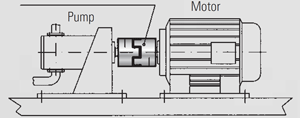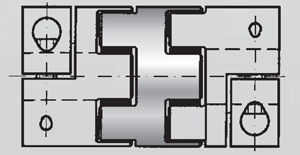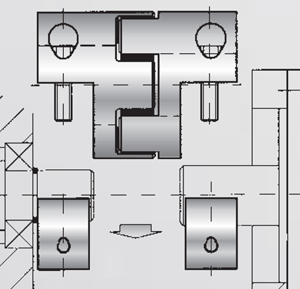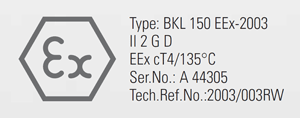Mechanically generated sparks, electrostatic discharge and high surface temperatures are all potential ignition sources in explosive atmospheres. Flexible couplings play a significant role in creating and/or eliminating these explosion hazards. Consequently, the European ATEX directive applies to couplings, and for good reason.
Requirements for ATEX certified equipment have grown increasingly important during the past several years, as a growing number of multinational organizations have adopted this standard, even when their operations are located outside of the European Union. Meanwhile, no domestic standard covers the explosion proofing of mechanical components like couplings.
To make a coupling explosion proof, special sizing and material considerations must be taken to guarantee proper grounding of electrostatic charges and minimize the risk of other mechanical ignition sources. Requirements become slightly more sophisticated when considering integral safety clutches.
Flexible Shaft Couplings
Flexible shaft couplings do more than simply join two shafts together for the transmission of rotary power. They isolate the bearings of independently supported shafts from the severe lateral and axial loading associated with misalignment, which addresses one of the more critical potentials for friction and heat generation in a mechanical drive system. Taking this a step further, mechanical safety clutch couplings protect equipment from overload by disconnecting the driveline within milliseconds of an unwanted torque spike. In explosive atmospheres, reducing even a fraction of a second from the amount of time spent attempting to drive a jammed mechanism can sometimes make a difference between safe running and disaster.
On the other hand, if not sized or installed correctly, flexible couplings can become dangerous in explosive atmospheres. First, overly misaligned couplings of all types will ultimately fail. Since a failed coupling normally means metallic parts colliding into each other or, worse yet, metallic parts rubbing against each other at full motor speed, alignment, sizing and routine inspection are obvious concerns.

Since careful alignment is also required, alternate mounting options are available to simplify alignment in foot mounted systems, which are more difficult to align than C-face mounts.
Jaw Type Couplings
For proper ATEX qualification, torque and misalignment ratings are reduced by 30 percent. With jaw type couplings, special conductive materials are also used for the injection molded urethane inserts, to guarantee a consistent path to ground for any electrostatic charge that may build up during operation. One advantage of using jaw type couplings is that they have a high torque density, meaning that the 30 percent safety factor used in the selection of a torque rating does not normally result in a coupling that is disproportionately large.
Since careful alignment is also required, alternate mounting options are available to simplify alignment in foot mounted systems, which are more difficult to align than C-face mounts. Full split collars allow the installer to carefully dial in motor and pump shaft locations for subsequent lateral installation of the coupling. This also helps to make servicing the coupling quick and convenient.
Additional options include dual flexture couplings, which can tolerate much greater amounts of misalignment, facilitating easier assembly through a wider tolerance. Inspection intervals, installation procedures and other detailed directions are then provided in the accompanying documentation, and serialized inscriptions are made on the couplings, detailing manufacturer accreditation and conformance to the standard.
Safety Clutch Couplings
Safety clutch couplings require a few more considerations. In these types, an array of ball bearings are spring loaded into a detent plate internal to the coupling. In a jam or overload, the ball bearings overcome the spring pressure and ramp out of their detents, releasing the driveline from further application of rotary power. Specialized disc springs are used to enhance sensitivity to movement from the ball bearings at overload, and multiple internal preloads are incorporated into the design to eliminate backlash. Both features serve to shorten the response time as much as possible.

Dual flex couplings can tolerate much greater amounts of misalignment, facilitating easier assembly through a wider tolerance.
While most common types of mechanical torque limiters are designed to ratchet during overload events, ATEX certified torque limiting couplings require a complete disengagement to avoid sparking and heat generation after the coupling has been released. In this case, the disc springs flip completely over center, relieving any pressure from the ball-detent interface, and allowing for only a light residual friction in the bearing as the coupling freely rotates. This is the ideal type of mechanical torque limiter for explosive atmospheres since it represents the least potential for sparking and heat generation.
To take safety a little further, ATEX 95a also requires that the clutch mechanism be sealed, so there is even less opportunity for the explosive vapor or dust to become ignited at the initial moment of disengagement. Re-engagement of the coupling is performed by applying axial pressure to the spring disc's retaining ring, and snapping the spring back over center, causing the ball bearings to seat back into their detents. The result is not only a safer response to overload, but also one that actually saves downtime by protecting pumps and other driveline components from damage.
Conclusion
Couplings may not represent the most obvious potential ignition source in plants and equipment, but they can both cause and eliminate the generation of heat and sparks. Whether a hazardous duty equipment installation is required to be ATEX certified or not, consider that a little more attention paid to couplings up front can save a lot of trouble down the road.

Full split collars allow the installer to carefully dial in motor and pump shaft locations for subsequent lateral installation of the coupling.

ATEX labeling
Pumps & Systems, May 2010

